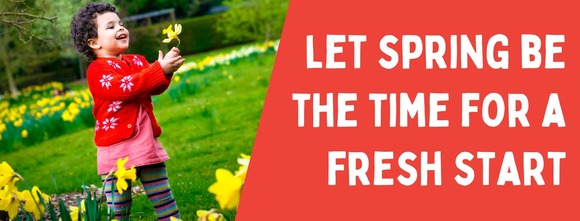 The spring is the perfect time to challenge your parents, staff and yourselves about healthy lifestyles so here are some resources to help you do that. Looking after children's, parents, staff members and your own health and wellbeing is really important.
 Wellbeing is simply defined as feeling good and functioning well. Improving wellbeing not only leads to the prevention of illness, but can lead to outcomes that include:
- Better physical health
- Healthier lifestyles
- Improved recovery from illness
- Fewer limitations in daily living
- Higher educational attainment
- Greater productivity, employment and earnings
- Better relationships with adults and children
- More social engagement
- Improved quality of life
So why not take the opportunity to re-focus on wellbeing? Healthy lifestyles work best when people are on board. For a start, why not begin with providing some information about wellbeing and take it from there? There are some great resources on the Energise Me website that can be used for staff and parents alike including the five ways to wellbeing quiz and a calculator to show your real activity levels. The Early Movers website is packed full of practical ideas for physical activities to help with babies and young children's physical development.
 Are you finding it hard to get out and about in the recent colder, wetter weather? If so, here's 10 ideas to get you all out and about...
1. Walk for life - look for signs of life on a trip to the park and you'll be surprised at how many you can see - some trees already have blossom, you may see birds collecting berries or flies or even prints from birds or animals feet. Talk about what you see and what you think may have caused them, what they eat and where they live.
2. Mud pies - you don’t need to have a mud kitchen, just some old tins, pots and pans. Find a damp patch of soil or add some water to compost and you will find endless opportunities to mix, ladle, pat, shape and "bake". Why not add in some leaves or herbs for decoration or to make your own perfumes/herb teas and potions?
3. Nature hunt - see how many different sized twigs or leaves you can collect. Count them out and talk about their size and shape. This is a good way of including maths and vocabulary into this activity too.
4. Tiny treasure hunt - take a small tub or egg box out and see how many different tiny things you can find that fit in it such as feathers, sticks, stones etc.
5. Mud or clay faces - mould some mud or clay that you have taken with you into a flat, round face shape. Add in some small stones for eyes and decorate with anything you can find to give it features such as twigs, grass and ferns. This helps develop the muscles needed for fine motor movements. Why not add them onto a tree trunk to boost your child's imagination?
6. Garden xylophone - add different amounts of water, earth, leaves, stones, nuts or seeds to some glass jars or metal bowls and then tap them with some small sticks to hear the different sounds.
7. Leaf chase - on a breezy day, get out and about with some dried leaves and see how many you can catch. Talk about the size, shape and if they are smaller or bigger, round or spiky to introduce maths and new vocabulary as you play.
8. Bark/leaf rubbing/tree appreciation - on a calm day look around and find the tallest or widest tree you can. Can you stretch your arms around/up it? Can your child stretch up tall/out wide like the tree or sway in the breeze like the branches?
9. Gardening - its never too early to start growing things. Now is a great time to plant broad beans, lettuce and some peas. You don’t have to have a large garden area - you can use vegetable bags/old plastic sacks or small pots and tubs filled with compost.
10. Swishy, swashy, splash! - enjoy the season - get out and play in the wet grass or muddy puddles. You could even merge your activity with a story such as We're Going on a Bear Hunt, which is great for including new vocabulary as you exercise. Don't forget your wellies!
 Don't forget the adults - staff are important too! Physical activity and wellbeing is not just for children. Why not add a physical activity goal to your annual reviews or supervisions or pop a notice up in the staff room and encourage regular chats about movement and self-care? (This can also work with your parents too).
Taking turns to lead a brief weekly takeover activity or have staff challenges to help you move more as a team and have fun too. Find out more about creating an active workplace on the Energise Me website.
 The start of a new year is a time for many people to look at their careers and change jobs, meaning employers potentially lose experienced workers and have positions to fill by now. Many of those choosing to change their job do so because of stress at work. April is stress awareness month - by taking some simple steps to prevent or tackle stress and support good mental health, employers can help workers to stay well, be happy and want to stay working with you. Whether work is causing a health issue or aggravating it, employers have a legal responsibility to protect their employees. Steps must be taken to assess and remove or reduce risks of stress. Equally if you are looking to recruit staff, by creating a culture where wellbeing is promoted, can work in your favour as people will want to work for you. Why not check out these resources and free training on the Health and safety executive website?
Download a one-page calendar to help drive change across Britain's workplaces by using key moments to promote the Working Minds campaign. Each month, there will be fresh assets for you to access and share with your networks and channels.
There is also some free online learning as an introduction to workplace stress and how to support good mental health. There are 6 short modules that guide you step by step with helpful tools and relatable, everyday scenarios along the way. It typically takes no more than an hour to complete, and you can come back as many times as you like.
 Has the contents of your children's lunchboxes taken a turn away from healthy options over the winter? If so, here are some great ideas to share with your parents.
Carrot and apple salad (beware of allergies - all ingredients can be swapped for other items such as peppers or sweetcorn or items left out. Herbs and seasoning/a small amount of dressing can be added to taste if needed).
Ingredients:
1 carrot
¼ of an apple
1 dessert spoon of raisins or sultanas
1 satsuma or an orange
1 dessert spoon of peanuts
2 small lettuce leaves/handful of mixed salad
Method:
- Wash the carrot, apple, satsuma/orange and lettuce and shake dry.
- Grate the carrot into a small bowl.
- Cut the satsuma/orange in half, squeeze the juice out of one half.
- Peel the other half of the satsuma/orange and carefully separate out the segments before cutting them into small pieces and adding them to the grated carrot.
- Chop into small pieces/slices and mix with the orange juice.
- Mix the carrot, apple and chopped orange and any remaining orange juice together.
- Add in the raisins and peanuts (if used), seasoning to taste with a few herbs or low fat dressing or pepper if needed.
- Serve with the lettuce/mixed salad.
|